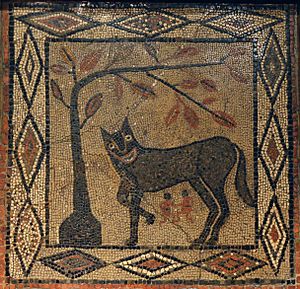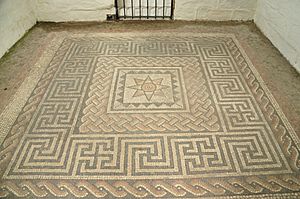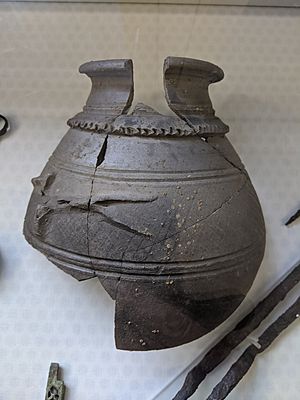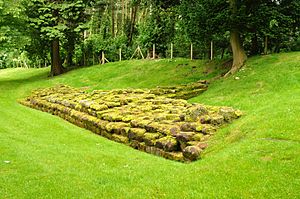Isurium Brigantum facts for kids
Isurium was an important Roman town and fort in the Roman province of Britannia. Today, you can find its remains at Aldborough in North Yorkshire, England. This site is known as the Aldborough Roman Site and is looked after by English Heritage.
Isurium was a key stop on major Roman roads. It connected Eboracum (which is now York) to places like the Antonine Wall and Luguvalium (modern Carlisle). Even today, the village of Aldborough still follows some of the old Roman street layouts. The local church even stands where the Roman market square, called the forum, used to be!
Contents
Discovering Isurium's Past
Isurium Brigantum was one of the most northern Roman towns. It was likely built around the late 1st or early 2nd century AD. This town became the main administrative center for the Brigantes tribe. The Brigantes were the largest and most northern tribe in Roman Britain. Towns like Exeter and Canterbury had the same important status as Isurium.
The Brigantes and Roman Arrival
The Roman writer Tacitus wrote about a Brigantes king named Venutius. His wife, Cartismandua, took over his power with her new partner. Cartismandua welcomed the Romans. At first, the Romans didn't see the Brigantes as a big threat. So, the Roman army mainly stayed in areas further south.
However, Venutius and his followers started attacking Brigantes towns. This happened towards the end of the 1st century. Because of this, the Roman army moved further north. Tacitus reported that Julius Agricola finally brought the Brigantes under Roman control in 79 AD. He then built Isurium.
How Isurium Got Its Name
The name Isurium probably comes from the Latin name of the river Iseur, which is now the River Ure. It's possible that the Brigantes had a settlement here before the Romans arrived. There are many ancient sites along the A1 road. This road partly follows the old Roman routes of Watling Street and Dere Street. You can also see three ancient standing stones called the Devil's Arrows about a mile from the site.
Interestingly, archaeologists haven't found clear evidence of a Brigantes settlement called Iseur. The most likely Iron Age settlement for the Brigantes was Stanwick, further north. Isurium probably started as a civilian settlement between a Roman fort and the River Ure. It became an important capital city around 160 AD.
Growing as a Roman Town
Isurium had strong buildings from early on, probably by the early 2nd century. Later, banks and ditches were added for defense. In the mid-3rd century, stone walls and four gates were built. The parts of the Roman town you can see today are only a small piece of what it once was.
Isurium thrived for the next 100 years. People built fancy homes with beautiful mosaic floors. In the middle of the 4th century, more defensive towers were added to the walls. Problems across the whole Roman Empire seemed to affect the town's success.
The End of Roman Rule
There isn't much evidence of people living in Isurium after the end of Roman rule in Britain. By the 7th century, the Anglo-Saxons had taken over the area.
Uncovering Roman Secrets
People have been interested in the ruins of Isurium for a long time. In the 16th century, a historian named John Leland wrote that farmers often found Roman coins and other items while plowing their fields.
Amazing Discoveries
In 2011, a special scan of the ground showed that there was once a large amphitheatre in Isurium! This discovery proved how important Isurium was as a major Roman town.
Another exciting find happened in 2004. A young archaeologist named Daniel Ebdon was using a metal detector for the first time. He found a Roman coin! This coin, along with others, is now on display at The Yorkshire Museum in York.
Visiting Aldborough Roman Site Today
The Aldborough Roman Site is managed by English Heritage. When you visit, you can see a large section of the town's strong wall with its defensive towers. You can also see two amazing mosaic floors that are still in their original place. These mosaics were once part of a Roman townhouse.
The museum at the site displays many archaeological finds. These items help us understand what life was like for Roman people in this northern capital. The Aldborough Roman town is a protected site under the Ancient Monuments and Archaeological Areas Act 1979.
Since 2016, a project called the Aldborough Roman Town Project has been studying the site. In 2019, one of the project leaders, Rose Ferraby, worked with a sound artist to create an audio tour. This tour helps visitors explore the Roman town in a unique way.
See also
 In Spanish: Isurium Brigantum para niños
In Spanish: Isurium Brigantum para niños





